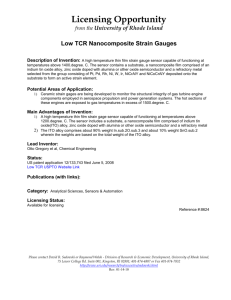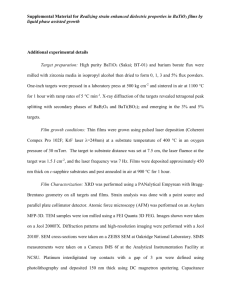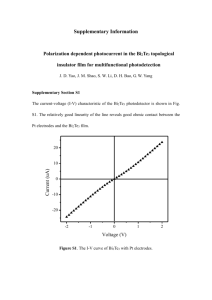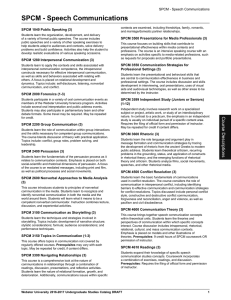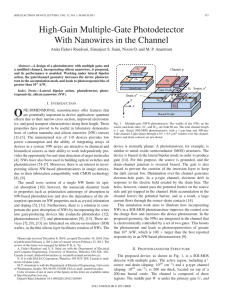APL_supplementary_revised_final
advertisement
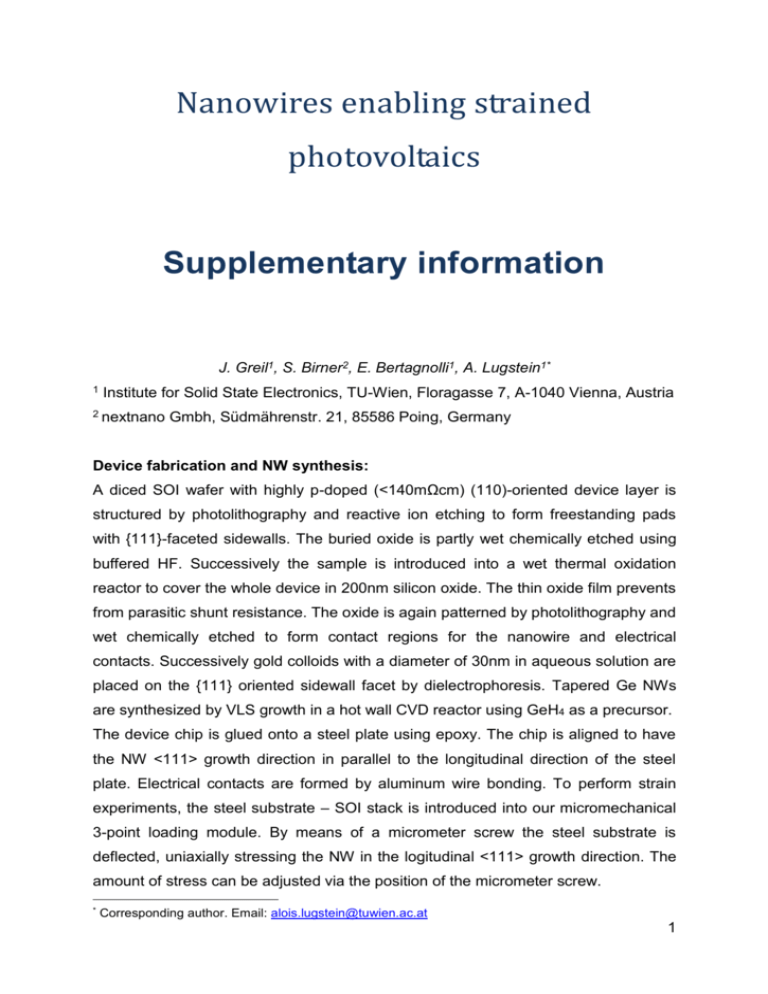
Nanowires enabling strained
photovoltaics
Supplementary information
J. Greil1, S. Birner2, E. Bertagnolli1, A. Lugstein1*
1
Institute for Solid State Electronics, TU-Wien, Floragasse 7, A-1040 Vienna, Austria
2 nextnano
Gmbh, Südmährenstr. 21, 85586 Poing, Germany
Device fabrication and NW synthesis:
A diced SOI wafer with highly p-doped (<140mΩcm) (110)-oriented device layer is
structured by photolithography and reactive ion etching to form freestanding pads
with {111}-faceted sidewalls. The buried oxide is partly wet chemically etched using
buffered HF. Successively the sample is introduced into a wet thermal oxidation
reactor to cover the whole device in 200nm silicon oxide. The thin oxide film prevents
from parasitic shunt resistance. The oxide is again patterned by photolithography and
wet chemically etched to form contact regions for the nanowire and electrical
contacts. Successively gold colloids with a diameter of 30nm in aqueous solution are
placed on the {111} oriented sidewall facet by dielectrophoresis. Tapered Ge NWs
are synthesized by VLS growth in a hot wall CVD reactor using GeH4 as a precursor.
The device chip is glued onto a steel plate using epoxy. The chip is aligned to have
the NW <111> growth direction in parallel to the longitudinal direction of the steel
plate. Electrical contacts are formed by aluminum wire bonding. To perform strain
experiments, the steel substrate – SOI stack is introduced into our micromechanical
3-point loading module. By means of a micrometer screw the steel substrate is
deflected, uniaxially stressing the NW in the logitudinal <111> growth direction. The
amount of stress can be adjusted via the position of the micrometer screw.
*
Corresponding author. Email: alois.lugstein@tuwien.ac.at
1
Measurement conditions:
All of the measurements presented were performed at room temperature.
NW FET synthesis and characterization:
NWs are dispersed on a highly doped silicon substrate with an oxide layer on top.
Contacts to the NW are formed by electron beam lithography, metal deposition and
lift-off. The substrate and the two NW terminals are connected as gate, source and
drain, respectively. Transfer characteristics are recorded with a semiconductor
analyzer and show increasing conductance with negative gate bias, indicating p-type
field effect response of the NW channel.
Raman & SPCM setup:
A confocal µRaman setup (Alpha300, WITec) is employed in backscattering
geometry with a grating monochromator and CCD camera (DV401_BV, Andor). The
excitation laser at 532nm is polarized in the NW axis and focused to a diffraction
limited spot of about 500nm in diameter. To determine in-situ the peak shift for Ge
NWs, the laser power is chosen to have negligible laser heating effects in the NW
(40µW). The upper bound on the temperature increase is estimated to be 30K from
the Raman data. In SPCM measurements, power is chosen, as to result in moderate
carrier injection (5µW) and no detectable temperature increase. The short circuit
current is amplified by a Keithley 428 current amp and recorded as a function of
position along the NW.
Internal Quantum Efficiency calculation:
IQE is calculated for a reflection coefficient R=0.44, an absorption coefficient
α=557.4·103cm-1 at 532nm and a 5µW gaussian beam with FWHM of 500nm
according to:
EQE
IQE
I ph hc
qPNW
EQE
(1 R)(1 e D )
With h Planck’s constant, c the speed of light, q the elementary charge, PNW the
power impinging on the projected NW surface area, λ the laser wavelength, and D
the NW diameter.
2
Correlation of integrated photocurrent to the effective potential:
Equation (5) in the script ( Eeff I ph ( x)dx ) states the proportionality of integrated
photocurrent and effective potential. To quantify the linear relationship we did SPCM
characterization while applying bias to the NW. As the applied bias equals the all
over band bending we can thus correlate the integrated photocurrent to the effective
potential. These measurements had to be performed in a 2-point configuration and
parasitic contact resistance might not be neglected. Therefore, the bias along the
nanowire can be lower than the applied bias to the device. The calculated effective
potential hence gives an upper limit for the potential drop along the nanowire.
Suppl. figure 1. Integrated photocurrent linescans along the nominally unstrained NW at 0V and 0.5V
bias.
Photocurrent spectroscopy:
White light from a broadband laser source (SuperK Extreme, NKT) is fiber-coupled to
a monochromator (SuperK Select, NKT), its output is polarized in the NW axis and
focussed on the sample using the SPCM setup. A current amplifier (Keithley 428)
and lock-in detection is used to record the spectra.
Bandstructure simulations:
The self-consistent band structure simulations were performed with the nextnano
simulation software.25 Self-consistent classical calculations solve the Poisson and
current equations for a Si-Ge-Si stack. The p-type doping density used for the silicon
mesas is 2x1017cm-3, in the germanium section 1015cm-3 were used to account for
3
the observed p-type behaviour. Input to the simulations was the local strain tensor
along the NW calculated from the µ-Raman measurements according to
111
k
xx yy zz
ij xx
1 1 1
s4 4
1
s1 1 2 s1 2
s44
,i j
2( s11 2s12 )
k 434cm 1
s11 2s12 0.44 x102 GPa1 (ref. 27)
s44 1.49 x102 GPa1 (ref. 27),
with the shift in the first order optical phonon peak position, 111 the applied strain
in the <111> growth direction of the Ge NW, ij the strain components in the crystal
coordinate system, sij the compliance constants of Ge. The correlation of Raman
peak position and uniaxial strain is enabled via the previously confirmed calibration
factor k=434cm-1.
Strain is incorporated in the simulations according to the Van de Walle model. 20
Drift current in the device is derived from the bandstructure by spatial differentiation
of the band edge extrema:
E
E
E E
I ANW n n c p p v ANW n c v .
x
x
x
x
with ANW the average NW cross-sectional area. The photo-induced electrically active
carrier density of electrons and holes was calculated to be n = p = 1016cm-3. The
mobility of holes is assumed to be 230cm2/Vs in close agreement with ref. 28. Equal
electron and hole mobilities µn=µp can be assumed from previous works on n- and ptype Ge NWs.29
Additional references
27
J.J. Wortman and R.A. Evans, J. Appl. Phys. 36, 153 (1965).
28
T. Burchhart, A. Lugstein, Y.J. Hyun, G. Hochleitner, and E. Bertagnolli, Nano Lett.
9, 3739 (2009).
29
D. Wang, Y.-L. Chang, Q. Wang, J. Cao, D.B. Farmer, R.G. Gordon, and H. Dai, J.
Am. Chem. Soc. 126, 11602 (2004).
4
